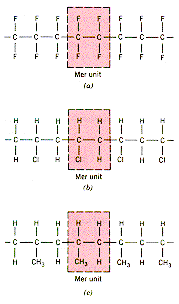|
A
polymer is a macromolecule made from repeating units known as mers. Typical
molecular weights are 106.
The mers are covalently bonded to form chain structures, branched chain
structures, or three dimensional structures. Different side groups may
be attached to the backbone so formed to give polymers with different properties.
Using the carbon backbone polymer polyethylene, the material has hydrogen
atoms located at each of the single bonds of the chain. Replacing all the
hydrogen atoms with fluorine atoms gives the polymer polytetrafluorethylene
, partial substitution of the chlorine onto the hydrogen sites yields polyvinyl-
chloride, and partial substitution by CH3
groups gives polypropylene. These linear molecules
are shown. Chain branching and cross-linking can occur if some of the hydrogen
sites are used to attach other backbone segments. To form three
dimensional structures it is necessary for the mers to have three (or more)
bonding sites. Such a mer is said to be tri-functional (or poly-functional).
The limiting example of this is carbon which is tetra- functional in its
(sp3) form and forms
the three- dimensional network polymer diamond. |
|
|
|
|
|
|
|
|
